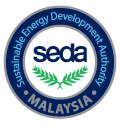The Ministry has introduced few solar PV initiatives to encourage Malaysia’s Renewable Energy (RE) uptake. From the RE townhall held on 12th July 2018, one of the key issues highlighted by the PV industry is the need to change the concept of NEM from the existing net billing to true net energy metering. This is will help improve the return of investment of solar PV under the NEM. Effective on 1st January 2019, the Net Energy Metering (NEM) will be improved by adopting the true net energy metering concept and this will allow excess solar PV generated energy to be exported back to the grid on a “one-on-one” offset basis. This means that every 1kWh exported to the grid will be offset against 1kWh consumed from the grid, instead of at the Displaced Cost previously.
The quota allocation for NEM is 500 MW up to year 2020. Quota allocation will be divided into domestic and non-domestic category. The NEM category has been divided into 4 categories which are Residential, Commercial, Industrial and Agriculture. The new NEM scheme is only applicable to Peninsular Malaysia and applicants must be a registered TNB customers. NEM is executed by the Ministry of Energy and Natural Resources (KeTSA), regulated by the Energy Commission (EC), with Sustainable Energy Development Authority (SEDA) Malaysia as the implementing agency.
The concept of NEM is that the energy produced from the installed solar PV system will be consumed first, and any excess will be exported to TNB on a “one-on-one” offset basis. This scheme is applicable to all domestic, commercial, industrial and agricultural sectors as long as they are the customers of TNB. The PV systems can be installed at available rooftops or car porch within their own premises.
Based on FiT experience, solar PV is a technology that requires minimal construction and with high take up rate compared to other RE technologies. One factor driving such growth is the declining cost of solar PV systems in recent years. As solar PV technology is more applicable to the NEM scheme, it is one of the technologies that allows the public at large to play an active role in mitigating climate change. They can generate clean energy, hence reducing the energy consumption and greenhouse gas emissions.
The NEM scheme is ideally suitable to complement the current FiT and Large Scale Solar schemes in achieving the 20% national RE target in electricity power mix by enabling more solar PV rooftop applications, and these efforts in turn help to reduce dependency on imported fossil fuels.
The energy generated by NEM consumers will be consumed first which implies that less energy will be imported from the utility. In many countries, the NEM scheme is effective to hedge against fluctuation or increase in electricity tariff in the future. This is especially relevant for consumers that fall under the high electricity tariff block.
Under the NEM scheme, any excess energy generated will be exported to the utility grid and will be paid on a “one-on-one” offset basis. The priority is for self-consumption, however some premises especially industrial or manufacturing sectors which may not be operating during the weekends may have excess energy exported to the grid. The credit shall be allowed to roll over for a maximum of 24 months.
Maximum capacity
For domestic or residential consumers, the allowable maximum capacity of the PV system installed is 12 kWac for single phase system or 72 kWac for 3 phase system.
Any person who uses, works or operates the installation shall require a license as stipulated under the ST Guidelines On Licensing Under Section 9 Of The Act. Licensing requirements are only applicable for solar PV system installation above 24kW for single phase and above 72kW for three phase.





